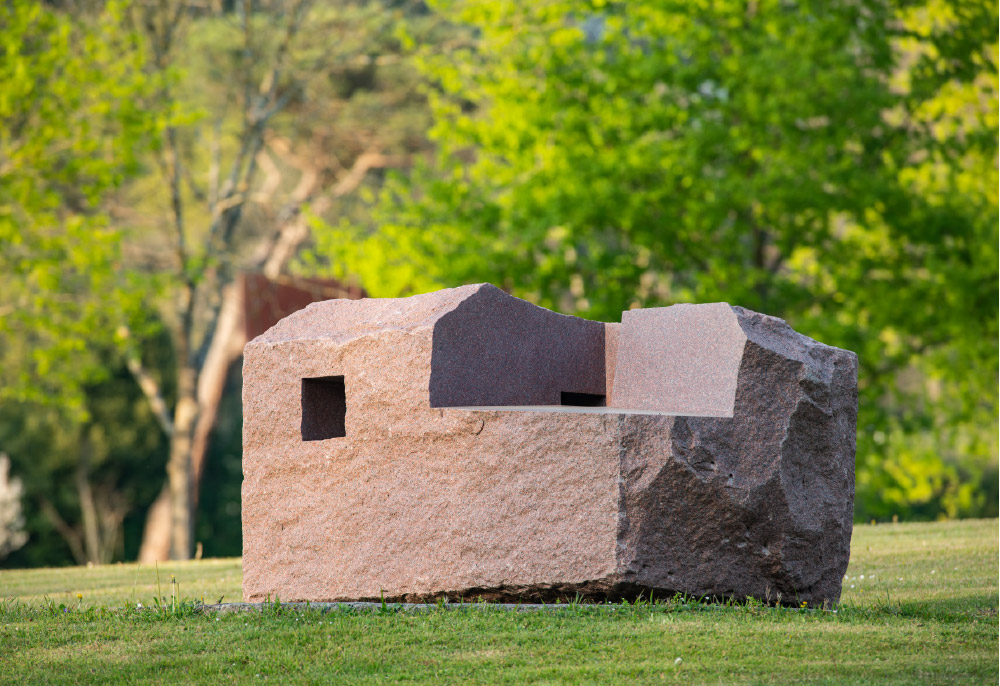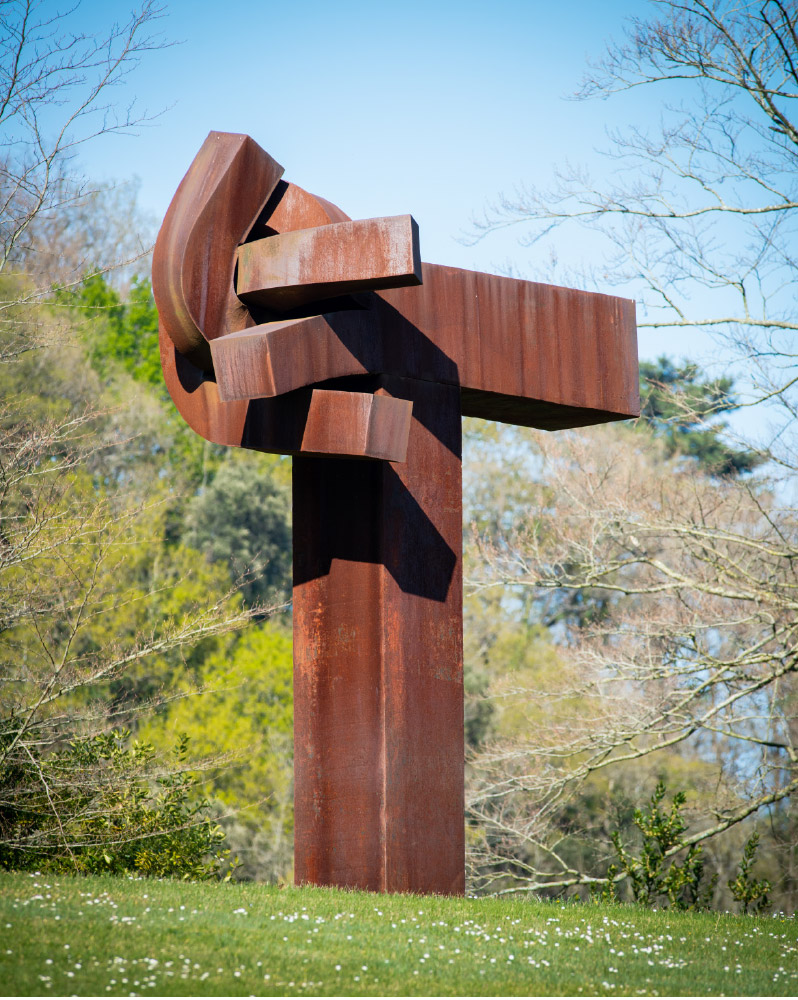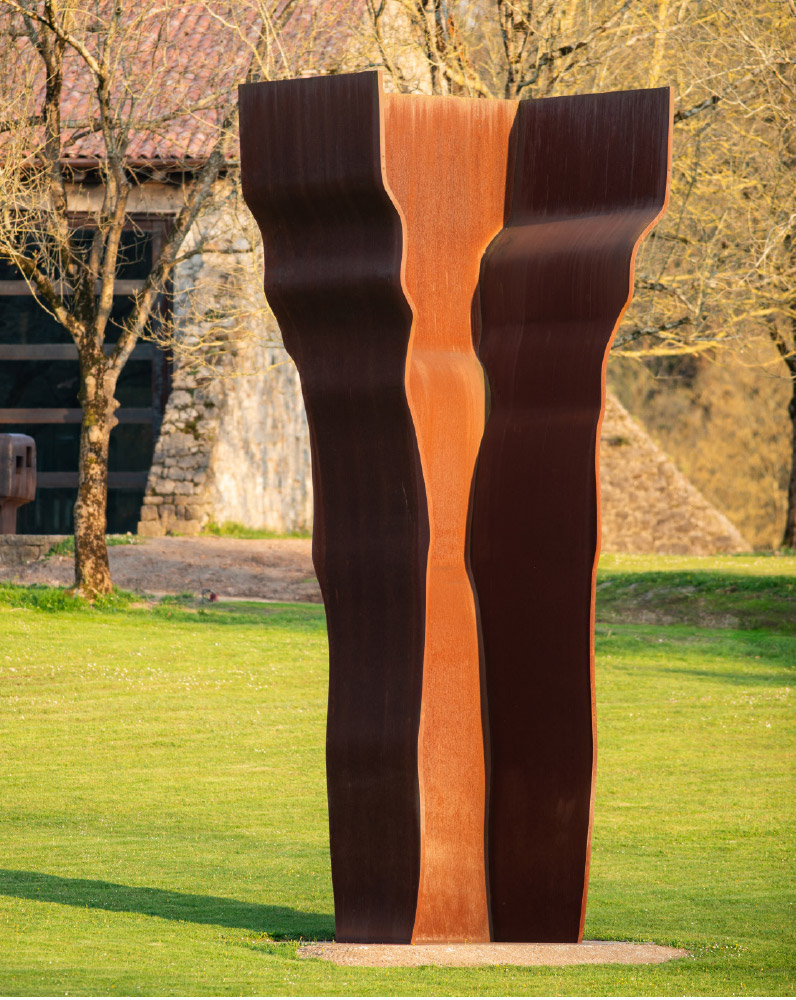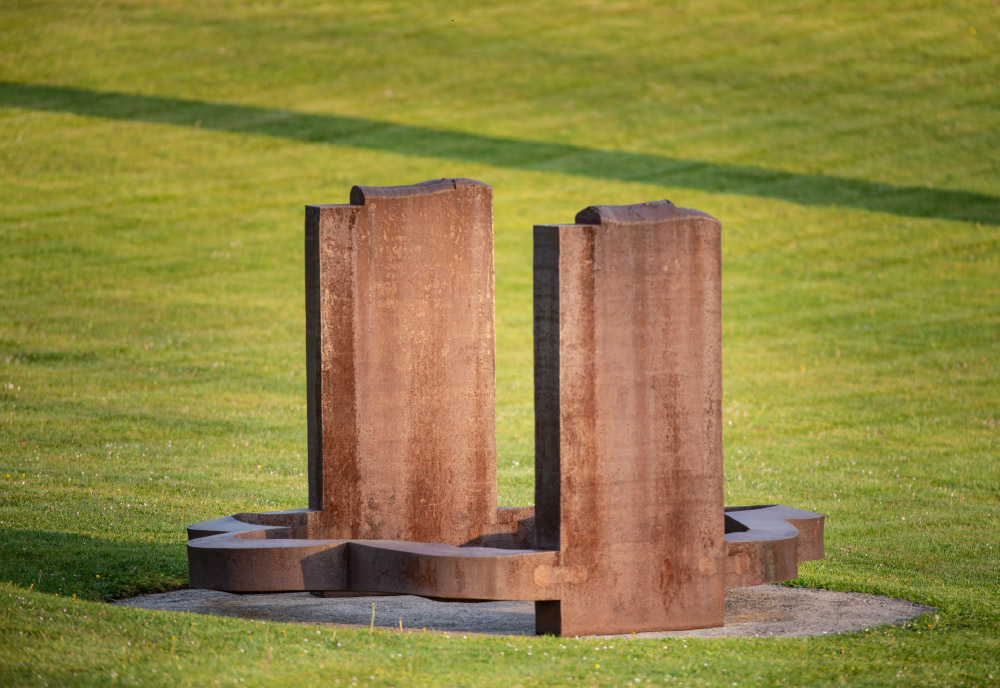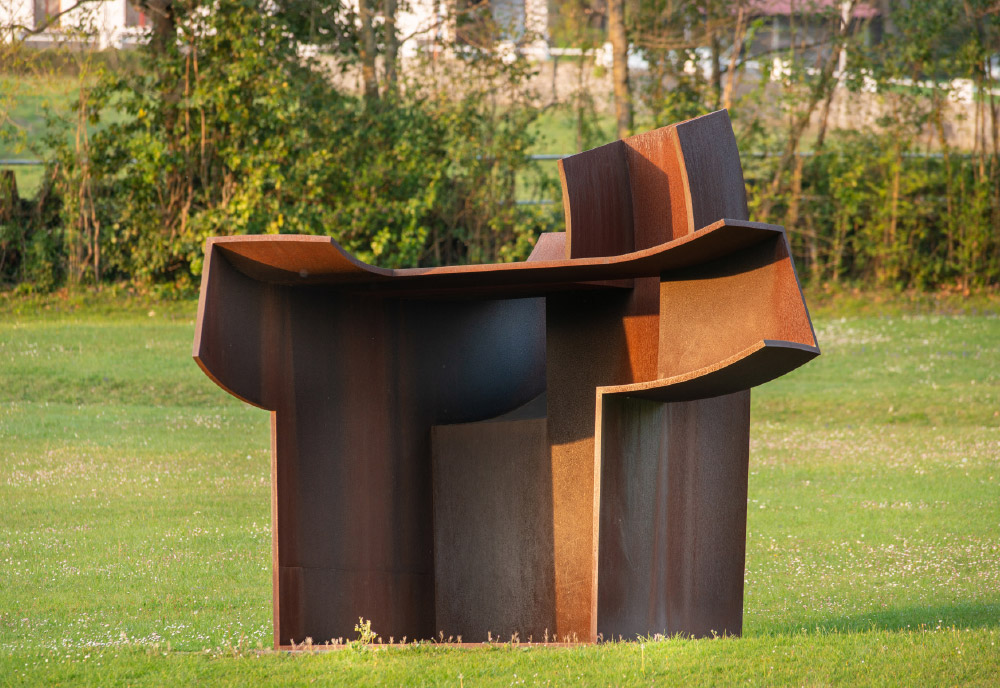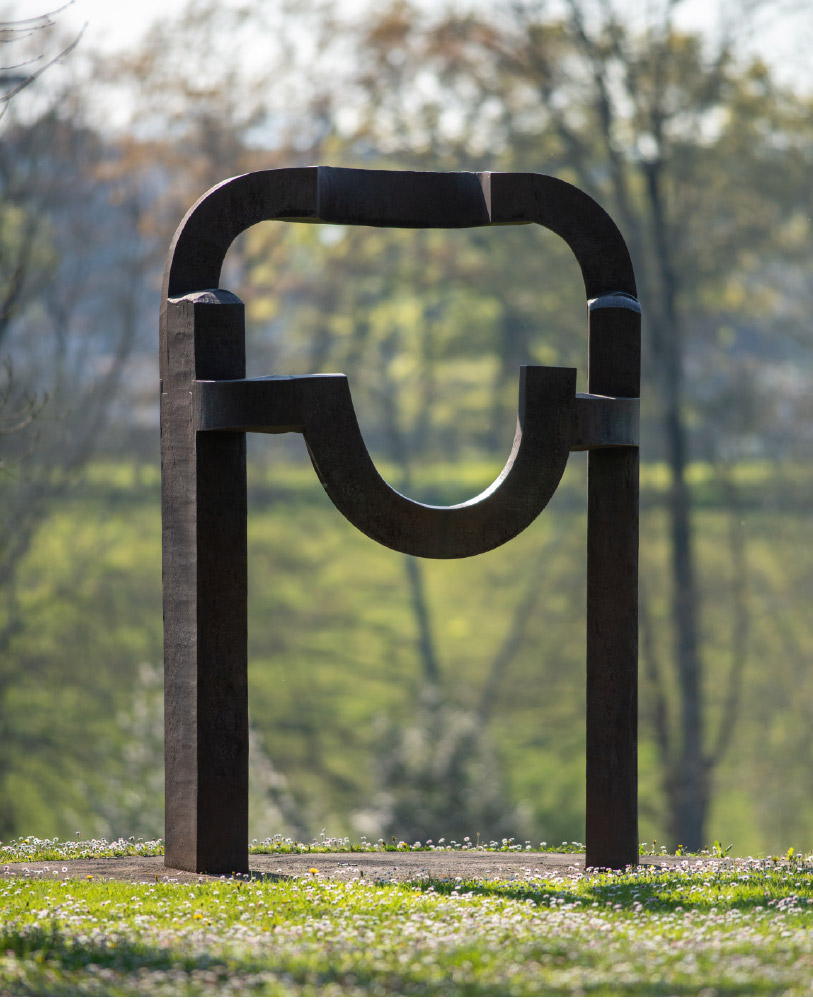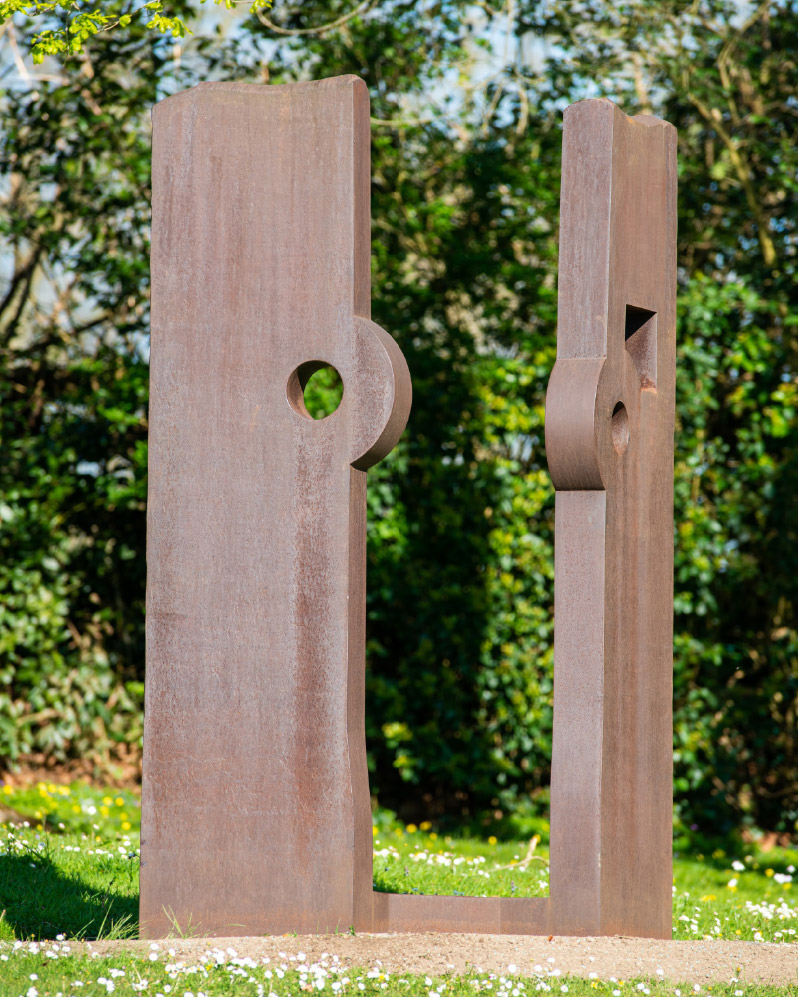Chillida Leku works
Selection of pieces from the collection placed in the Museum
Lo profundo es el aire
[How Profound is the Air]
The title of this work comes from a verse by Jorge Guillén, a poet from Valladolid and a member of the Generation of ’27. The two creators met at Harvard University in 1971 and struck up a friendship. Years later, when Chillida wanted to pay tribute to Guillén, he found this verse: “Más allá, lo profundo es el aire” (“Beyond, how profound is the air”). It was the link between the two artists. This series is a tribute to the poet: “When I paid homage to Jorge Guillén, I first re-read his entire work to try to find a concept through which we could both be on the same page. I found it in Cántico. One part says ‘Lo profundo es el aire,’ which for me is a perfect concept.”
All sculptures in the series were an exploration into his unrealized project on Tindaya Mountain on the island of Fuerteventura. His starting point was a sculpture in alabaster in 1984 called Mendi Huts, which means “empty mountain”: “Years ago I had a vision that I sincerely believed was utopian. It was to create a space within a mountain for men of all races and colours, a great sculpture of tolerance. One day the opportunity arose to create the sculpture on Tindaya, Fuerteventura. This was the mountain where utopia could be reality. The sculpture would help protect the sacred mountain. The large space created within would not be visible from outside, but the men who penetrated its heart would see the light of the Sun, of the Moon, inside a mountain leaning towards the sea, and towards the horizon, unreachable, necessary, non-existent...”
Lotura XXXII
[Knot XXXII]
This colossal steel sculpture weighing more than 64 tonnes was created in the industrial forge in Reinosa, Cantabria. Chillida chose to use a forge rather than a foundry since each process is radically different. Chillida did not work with molds or with molten metal. To forge iron is to battle with it. The person forging can work only with the part that has been heated. By forging, Chillida bent the iron to his will, while allowing the metal to freely express itself. The material naturally expanded and contracted in curves. His chosen material in this case was Corten steel—the high-copper alloy in the surface layer provides anti-rust protection against the elements. Chillida did not declare his work complete until the first layer of extremely orange rust appeared on the surface. Different colors of steel are evident in the sculptures in the museum; the darker the tone, the older the piece. Lotura, which is Basque for knot or union, is made of two pieces of solid steel. The upper piece exhibits the characteristic feature of this series: four knotted arms emerging from one block. The lower piece constitutes the base upon which the work is assembled.
Buscando la luz I
[Searching for Light I]
The creation of this monumental 22-tonne piece entailed great technical difficulty. The work comprises three distinct and completely asymmetrical steel sheets joined by a series of rivets. Walking around the work provides two very different perspectives: the contrast between full and empty. From behind, the viewer sees a solid piece that raises itself proudly towards the sky. From the front, the opening, space, emptiness. For Chillida, space should be accessible. Once inside the sculpture, its own shapes become wave-like. They seem to take on movement and turn their gaze upward in search of the light, hoping to reach it not just physically, but also poetically and spiritually.
De música III
[On Music III]
Music was a constant presence in Chillida's life. Contrapunto (Counterpoint), Música de las esferas (Music of the Spheres), Música callada (Silent Music) and the series De música (On Music) have titles that demonstrate his relationship with harmony, rhythm and sound. The sculptures in the De Música series are inspired by a text by Saint Augustine where the philosopher considers music and its metric peculiarities as a means of communication with the divine.
Among the composers admired by Chillida were Vivaldi, to whom he paid two tributes, and Mozart, the subject of one of his infinite questions: “Why did Mozart compose the majority of his music in quick movements? Could he have sensed that he didn’t have time; that, unfortunately, there was no room in his work for too many adagios?” However, it was Bach whom he most admired and who held a privileged place in his thought and in his creation.
This sculpture was originally intended for Bonn’s Cathedral Square in Germany. However, due to project modifications, Chillida created another piece for Bonn, and De música III remained in the museum. Its shape is inspired by the floor plan of the cathedral. The semi-circles allude aesthetically to the shape of the apse.
Consejo al espacio IV
[Advice to Space IV]
“From space, together with its brother time, under persistent gravity, feeling matter as a slower form of space, I ask myself with amazement about what I don’t know. I work to know, and I value knowing more than knowledge. I believe that I should try to do what I don’t know how to do, try to see where I can’t see, to recognize what I don’t recognize, to identify in the unknown. In these processes, which are similar to those in creative science, there are many difficulties.” —Eduardo Chillida
Chillida's entire body of work is characterized by the reasoning between matter and space. This was one of his greatest concerns. He was interested in the dialogue between full and empty. However, for the dialogue to work, the material had to be solid. A hollow material by contrast would contain a hidden and inaccessible space within, which to Chillida would be untruthful. The space had to be both visible and accessible. The sculptor created spaces that the spirit can inhabit, constituting meeting places with the work and with oneself.
Arco de la libertad
[Arch of Freedom]
This work is a clear example of the importance that Chillida placed on the particular environment where his sculpture would be installed. The Arco de la libertad was commissioned by the city of Paris for a central square and the original project included an area for pedestrians only. Chillida was enchanted by the idea and began working on the sculpture. Once complete, Chillida was told that the square would not, in fact, be closed to vehicles. In view of these new parameters, he declined to deliver the piece and left the sculpture instead in a strategically chosen location in the museum. The positioning of the Arco de la libertad marks the space between the open fields and the wooded area, as well as the start of a boulevard that connects the country house with the English-style villa.
Homenaje a Balenciaga
[Homage to Balenciaga]
Chillida paid many homages throughout his artistic career. He created more than 100 works in honor of various public figures, artists, writers, musicians, poets and philosophers who were particularly significant to him. Walking through the museum, the visitor encounters works dedicated to Georges Braque, Jorge Guillén, Luca Pacioli, Alexander Fleming and a sculpture in honor of the fashion designer Cristóbal Balenciaga.
Chillida’s connection with Balenciaga dates back to his early childhood. Chillida’s maternal grandmother, Juana Eguren, was the owner of two hotels in San Sebastián, and Balenciaga visited her often, accompanied by prominent people from the fashion world. Grandmother Juana provided great support to the couturier at a critical point in his life, when he left Getaria. She encouraged him to travel to Paris to develop his trade. Years later, Chillida initiated a friendship with the master couturier, whom he found to be humble, sensitive and intelligent. The elegance of this sculpture alludes to the best of Balenciaga’s designs. The two steel pieces generate an internal space that suggests a female silhouette between the blocks.



